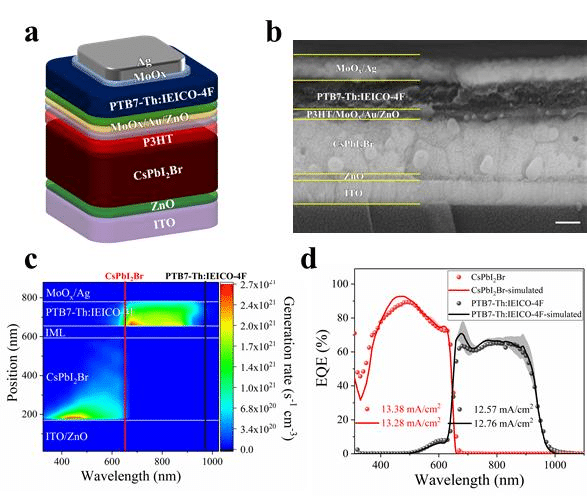Researchers at South Korea’s Ulsan National Institute of Science and Technology (UNIST) claim to have achieved a conversion efficiency of 18.04% in a hybrid tandem solar cell based on inorganic perovskite and organic bulk heterojunction (BHJ) technologies.
The scientists have described the performance achievement as the highest efficiency rate in any tandem device based on perovskite and organic materials. It is the result of the near-optimal absorption spectral match between the two sub-cells of the device, they added.
The optical properties of front and back cells were matched with a cesium-based inorganic perovskite known as CsPbI2Br and the so-called PTB7-Th:IEICO-4F blend, which is particularly attractive for semi-transparency, imaging, and tandem device applications. Prior to their combination in a single tandem device, the CsPbI2Br sub-cell showed an efficiency of 9.20%. Based on PTB7‐Th:IEICO‐4F, it exhibited an efficiency of 10.45%.
“The hybrid tandem device designed in this study demonstrated improvement in long-term stability under humidity stress, which is due to the hydrophobicity of the organic BHJ back-cell layer,” the researchers added.
They said that inorganic perovskite/organic hybrid tandem devices have the potential to reach efficiencies close to 28% by improving the external quantum efficiency (EQE) and reducing energy losses in the sub-cells. The EQE is the ratio of the number of energy carriers harvested by the solar cell to the number of photons of a given energy incident on the cell itself.
In 2017, UNIST researchers developed a new method for the production of inorganic-organic perovskite solar cells. They achieved record efficiency levels of 22.1% in small cells and 19.7% in cells measuring 1 square centimeter. This year, UNIST researchers achieved a conversion efficiency of 25.17% in a perovskite solar cell by minimizing the deformation for the microstructure of photoactive layers.
This content is protected by copyright and may not be reused. If you want to cooperate with us and would like to reuse some of our content, please contact: editors@pv-magazine.com.




1 comment
By submitting this form you agree to pv magazine using your data for the purposes of publishing your comment.
Your personal data will only be disclosed or otherwise transmitted to third parties for the purposes of spam filtering or if this is necessary for technical maintenance of the website. Any other transfer to third parties will not take place unless this is justified on the basis of applicable data protection regulations or if pv magazine is legally obliged to do so.
You may revoke this consent at any time with effect for the future, in which case your personal data will be deleted immediately. Otherwise, your data will be deleted if pv magazine has processed your request or the purpose of data storage is fulfilled.
Further information on data privacy can be found in our Data Protection Policy.